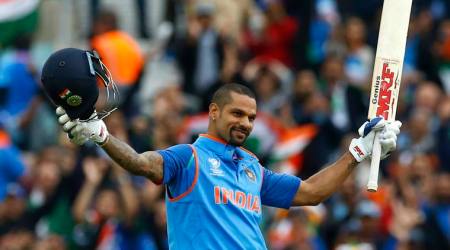 Hardik Pandya celebrates after dismissing Faf du Plessis during India’s Group B match against South Africa in London on Sunday. India trounced South Africa by eight wickets. AP photo
Hardik Pandya celebrates after dismissing Faf du Plessis during India’s Group B match against South Africa in London on Sunday. India trounced South Africa by eight wickets. AP photo
When AB de Villiers dives, he does so like Superman on a world-saving mission, defying both reason and gravity. But on Sunday, he couldn’t save his own world with that dive. His kryptonite was MS Dhoni, whose Spiderman-like reflexes off Hardik Pandya’s throw were so quick and stealthy that de Villiers was caught way short of his crease.
To be certain, there was no scope for the tight single that culminated in de Villiers’s run out. There was no need either. South Africa were ambling at 140/2 when de Villiers had this sudden rush of blood. He had called for the run despite having seen Faf du Plessis push the ball firmly enough for Hardik Pandya to hardly move at point. Maybe du Plessis could have yelled out a firm “no”, but he might have trusted the skipper’s discretion and hence reciprocated. It was the first of the two mindless run outs, which happened in the space of five balls, that symbolised South Africa’s edginess at the Oval. And India’s sharpness and urgency.
Shortly after de Villiers’s exit, du Plessis’s own judgment creaked. This one was more dubious, bordering on the farcical. Outside-edging the ball to short thirdman, du Plessis set off, then paused and then set off again, before turning and running back to his crease without realising Miller was just inches behind him. The photo-finish frame of both batsmen stretching the sinews to make the crease would be the butt of much ridicule, but there wasn’t a more obvious sign of South Africa’s inexplicable desperation.
Put in to bat, this is exactly where they didn’t want to be with the 30th over around the corner. But it was as much as a case of them shooting themselves on the foot as India not letting them off the hook. For even after their dismissals they had a fearsome middle to lower order in tow. But like they seem to do quite often these days, Virat Kohli’s team once more found a way to get the better of a challenging situation. It’s the greatest strength of their team, to make things happen nearly out of nothing.
Sluggish pitch
The Oval pitch was flat even if a little sluggish. And the South African openers, even the usually aggressive Quinton de Kock, started tentatively. It was a tricky scenario for Kohli. With Umesh Yadav having been replaced by R Ashwin, he now had to take a punt with using Jasprit Bumrah, who he generally prefers using in the middle to late overs, with the new-ball. This was, if anything, an opening for the Proteas to put the Indians off early on. But they couldn’t. Bhuvneshwar Kumar and Bumrah never let them get away.
It’s not only as a team that India have begun overcoming conditions and scenarios. The key to their recent success is how even their players have managed to do this at an individual level. With no swing on offer, you would have thought Kumar would be handicapped enough to be considered a liability. That Yadav might have been the one to play ahead of him. But Kumar was India’s best bowler against Sri Lanka despite the heavy defeat.
What he has done remarkably so far in the tournament is compromise on his primary strength and shorten his length slightly rather than obstinately stick to bowling fuller in search of movement. It meant de Kock was never allowed the opportunity to connect whenever he tried to swing across the line. Instead the left-hander, who’s been India’s scourge on multiple occasions, was made to change his game and play more sedately.
For someone who likes to dominate from the start, he crossed 50 only in the 24th over with just four boundaries — the slowest of his career. By then the Indian spinners, paired together for the first time in the tournament, had put a stranglehold of their own. His attempt to break the shackles off Ravindra Jadeja with a very predetermined sweep only saw him bowled.
Amla’s plight was the same, as both Kumar and Bumrah neither offered him width — except on a couple of occasions — nor did they drift anywhere close to his pads. They kept pegging away on a length and Amla too ended up getting stuck. And he was the first to succumb, in expected fashion too, trying to cut a ball that was too close to him.
After the first 10 overs, South Africa had crawled to 35/0. They had all their wickets intact, and the Indians had done well by not going for wickets on a pitch that wasn’t designed for doing so. What they did right was squeeze them out. The run-outs were just an inevitable outcome in the face of the relentless pressure that the Indians had kept on them.
The sign of a dominant team is not just in putting the shackles on the opposition, but to move in for the kill. Once de Villiers and Miller were gone and the panic had set in, the Indians swooped in and finished them off.
India were never going to be stretched in making 192, and they finished the game off clinically with Virat Kohli and Shikhar Dhawan scoring chanceless 70s, before Yuvraj Singh smashed a massive six over deep mid-wicket to set up a semifinal clash against Bangladesh at Edgbaston.

